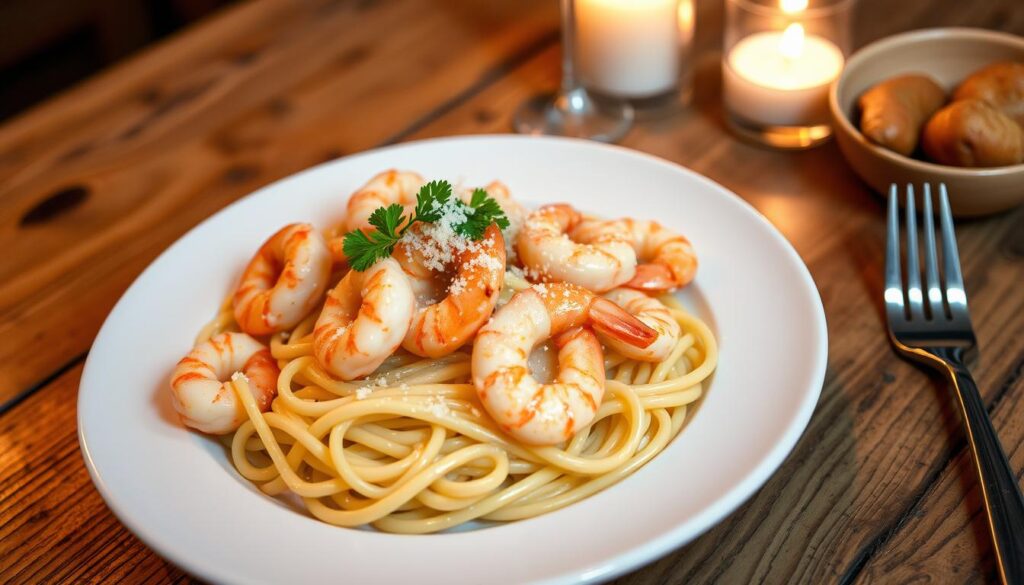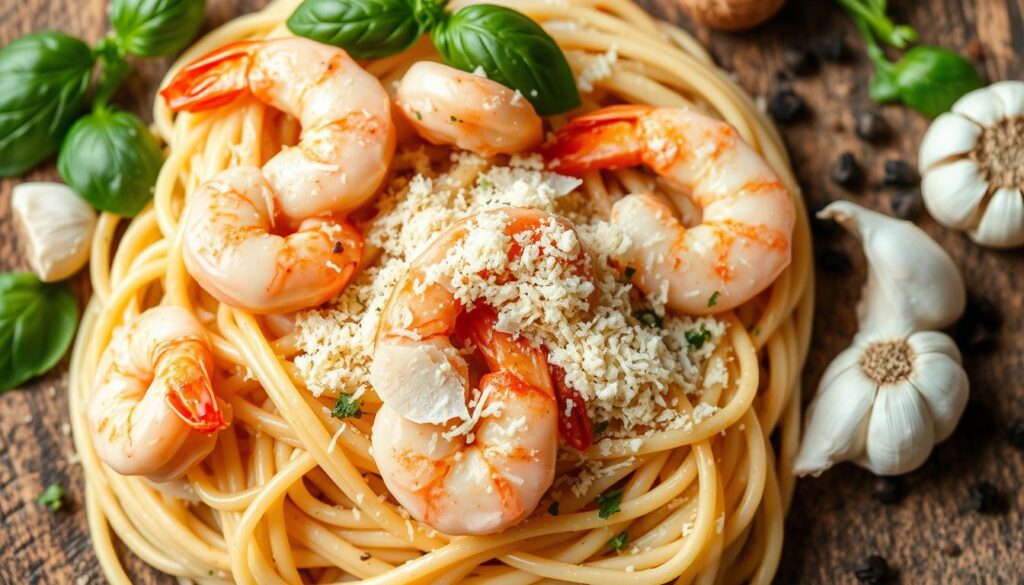
Every kitchen has its special moment. That’s when simple ingredients turn into a fantastic meal. For me, creamy shrimp pasta is like culinary poetry. It brings comfort and excitement together.
Those first moments of sizzling shrimp and velvety sauce are unforgettable. It’s more than just cooking. It’s about making memories.
Imagine tender shrimp in a rich sauce, with perfectly cooked pasta. This dish is simple yet versatile. It’s perfect for both beginners and seasoned chefs.
Key Takeaways
- Creamy shrimp pasta combines luxurious flavors with simple cooking techniques
- Total preparation time is approximately 30 minutes
- Serves 4-6 people comfortably
- Highly customizable with various seasoning options
- Nutrition-packed meal with balanced protein and flavor profile
Understanding the Perfect Shrimp Selection
Choosing the right shrimp is key to a great creamy pasta dish. The type of shrimp you pick affects the taste and texture of your meal.
Shrimp Size and Count Matters
Knowing about shrimp sizes is important for cooking. Shrimp are sold by count per pound. This count shows their size and the right recipe for them.
- Small shrimp (51-60 count): Best for pastas
- Medium shrimp (41-50 count): Versatile option
- Large shrimp (21-30 count): Perfect for grilling
Fresh vs. Frozen Shrimp Debate
“Not all frozen shrimp are created equal” – Seafood Experts
Many “fresh” shrimp sold have been frozen before. For creamy pasta, frozen shrimp can work well if thawed right.
| Shrimp Type | Pros | Cons |
|---|---|---|
| Fresh Shrimp | Immediate use | Limited shelf life |
| Frozen Shrimp | Longer storage | Requires careful thawing |
Cleaning and Deveining Techniques
Getting rid of the shrimp’s digestive tract is important. Shell-on shrimp often taste better, so keep the shell on during cooking.
- Rinse shrimp under cold water
- Make a shallow cut along the back
- Remove dark vein using a paring knife
- Pat dry with paper towels
Pro tip: Don’t marinate shrimp in acidic solutions for more than 30 minutes. This helps avoid a mushy texture.
Essential Ingredients for Creamy Shrimp Pasta
To make the perfect creamy shrimp pasta, you need top-quality ingredients. These ingredients will decide the dish’s flavor and texture. It’s all about choosing the right stuff.
- Fresh large shrimp (1 pound)
- High-quality pasta (500g spaghetti or linguine)
- Heavy cream (1 cup)
- Freshly grated Parmesan cheese (1 cup)
Quality ingredients and the right amounts are key for a great creamy shrimp pasta. Each part adds to the dish’s rich flavors.
| Ingredient | Quantity | Purpose |
|---|---|---|
| Shrimp | 1 pound | Primary protein |
| Garlic | 4 cloves | Aromatic base |
| Olive Oil | 2 tablespoons | Cooking medium |
| Butter | 2 tablespoons | Flavor enhancement |
For extra flavor, try using Herbes de Provence or Italian seasoning. The right herbs can make your pasta truly special.
“Great pasta begins with exceptional ingredients” – Chef’s Wisdom
Pro tip: Use fresh ingredients and prep them before cooking. This makes cooking easier and ensures a tasty dish that will wow your guests.
Mastering the Art of Pasta Selection
Choosing the right pasta can make your shrimp linguine or fettuccine alfredo amazing. The pasta you pick affects how the sauce sticks and makes your meal unforgettable.
Pasta is key to a great creamy seafood dish. Its texture, shape, and cooking method are crucial for success.
Best Pasta Shapes for Cream Sauces
For shrimp linguine, some pasta shapes are better at holding creamy sauces. Here are the best ones:
- Linguine: Flat and wide, perfect for even sauce distribution
- Fettuccine: Broader noodles that hold cream sauces beautifully
- Tagliatelle: Slightly narrower but equally effective for cream-based dishes
Al Dente Cooking Guidelines
Cooking pasta to al dente is all about precision. For most pasta, follow these steps:
- Boil water with generous salt
- Cook fettuccine for 9-12 minutes
- Test pasta firmness by biting a strand
- Drain immediately when texture is slightly firm
Pasta Water Secrets
“The secret to a perfect shrimp fettuccine alfredo lies in the pasta water!” – Professional Chef
Using pasta water is a game-changer for cream sauces. It helps mix sauce ingredients, making your shrimp linguine silky and top-notch.
Creating the Perfect Garlic Cream Sauce
Making a delicious garlic cream sauce is key to making your garlic shrimp pasta stand out. This sauce will turn simple ingredients into a dish that wows everyone.
Here are the main parts for a garlic cream sauce that’s hard to resist:
- 4 tablespoons of high-quality butter
- 2 tablespoons of freshly minced garlic
- 1/3 cup heavy cream
- 4 ounces cream cheese
- Parmesan cheese for depth of flavor
“The key to a perfect sauce is balancing flavors and creating a silky smooth texture.”
To start, melt butter in a pan over medium heat. Add minced garlic and cook until it smells great, but don’t let it burn. It’s important to cook the garlic slowly to get the best flavor without bitterness.
Then, mix in cream cheese and heavy cream, whisking until it’s smooth. Add Parmesan cheese slowly to thicken the sauce and add a rich taste. If you like a little spice, add some red pepper flakes to your garlic shrimp pasta.
Pro tip: Always use fresh garlic for the most vibrant flavor in your cream sauce.
Professional Tips for Cooking Shrimp
Learning to cook shrimp well is key to a tasty creamy shrimp pasta. The right cooking methods can make your dish go from good to great. This ensures your shrimp are tender and full of flavor.
Temperature Control Methods
Getting the temperature just right is crucial for cooking shrimp. Use medium-high heat to get a nice sear without overcooking. Aim for a temperature of 350-375°F. This helps cook the shrimp quickly while keeping them soft.
- Start with a preheated pan
- Use olive oil or butter for optimal flavor
- Avoid overcrowding the cooking surface
Timing and Color Indicators
Timing is everything when cooking shrimp for pasta. Shrimp usually take 2-3 minutes to cook. They go from gray to pink and curl up a bit. Look for these signs to avoid tough, overcooked shrimp.
| Shrimp State | Cooking Time | Color Indication |
|---|---|---|
| Raw | 0 minutes | Gray, straight |
| Cooking | 2-3 minutes | Turning pink, slightly curled |
| Perfectly Cooked | 3 minutes | Bright pink, C-shape |
Seasoning Techniques
Boost your shrimp’s flavor with smart seasoning. Mix kosher salt, black pepper, and garlic powder for a sweet taste. Try dry-brining with salt and baking soda for extra softness.
“The secret to perfect shrimp is in the details: temperature, timing, and seasoning.” – Culinary Expert
Pro tip: Take shrimp off the heat when they’re just pink. The heat will keep cooking them, making them tender and juicy for your creamy pasta.
Wine and Cream Sauce Pairing Guide

Choosing the right wine can make your creamy shrimp pasta special. The right wine brings out the seafood and cream sauce’s flavors.
“The perfect wine doesn’t just complement a dish—it elevates it.” – Sommelier’s Wisdom
For shrimp pasta, pick white wines that match the creamy texture. Light, crisp wines are best with seafood pasta.
- Chardonnay: Buttery notes complement cream sauces
- Pinot Grigio: Light and refreshing option
- Sauvignon Blanc: Bright acidity cuts through richness
Think about the sauce’s strength and the shrimp’s flavor when picking wine. Lighter wines help keep the seafood’s taste in the spotlight.
| Wine Type | Flavor Profile | Pairing Score |
|---|---|---|
| Chardonnay | Buttery, Smooth | 90% |
| Pinot Grigio | Crisp, Light | 85% |
| Sauvignon Blanc | Citrusy, Acidic | 88% |
Pro tip: Serving temperature matters! Chill your white wine to 45-50°F for optimal taste.
Elevating Your Dish with Fresh Herbs
Fresh herbs can turn a simple shrimp pasta into a work of art. By adding the right herbs, your dish can reach new heights of flavor. Using fresh herbs is more than just seasoning. It’s about creating a feast for your senses.
Perfect Herb Combinations for Shrimp Pasta
Here are some top herb pairs for shrimp pasta:
- Parsley and Chives: Bright, fresh flavor with a hint of onion
- Basil and Oregano: A taste of the Mediterranean
- Thyme and Tarragon: Elegant and sophisticated
Herb Addition Techniques
Timing is key when adding fresh herbs to your pasta. Delicate herbs like basil and parsley should be added just before serving. This keeps their flavor and color bright. Thyme, being a bit harder, can be added while cooking for a deeper taste.
| Herb | Flavor Profile | Best Added |
|---|---|---|
| Parsley | Fresh, slightly peppery | Final garnish |
| Basil | Sweet, aromatic | Last minute |
| Thyme | Earthy, robust | During cooking |
“Fresh herbs are the secret weapon of professional chefs, transforming simple dishes into extraordinary culinary experiences.”
Pro tip: Chop fresh herbs right before adding them for the best flavor and aroma. While dried herbs can do in a pinch, nothing beats the freshness of herbs on your shrimp pasta.
Troubleshooting Common Sauce Issues
Cream sauce can be tricky, but with the right techniques, you’ll get it right every time. Knowing common tips will help you fix your sauce and avoid disasters.
“The difference between a good sauce and a great sauce is knowing how to fix unexpected challenges.” – Professional Chef
When your cream sauce goes wrong, stay calm. Here are some ways to fix common sauce problems:
- Grainy Texture: This is often due to pre-grated Parmesan. To fix it, try these:
- Use freshly grated Parmigiano-Reggiano
- Grate cheese with particles less than 1mm
- Incorporate cheese slowly while stirring constantly
- Sauce Separation: To avoid this, do the following:
- Maintain low heat
- Temper cold cream before adding
- Avoid boiling dairy-based sauces
Temperature control is key in fixing cream sauce issues. About 40% of sauce failures happen because of wrong heat. Always use low heat and stir often to keep it smooth.
For the best cream sauce, use a shallow skillet for better mixing. Also, add pasta water to help ingredients stick together. Remember, a great sauce takes technique and patience.
Adding Depth with Parmesan and Seasonings
Take your creamy shrimp pasta to the next level with Parmesan cheese and seasonings. Freshly grated Parmesan turns a simple dish into a work of art. It adds rich, umami flavors that delight your taste buds.

Choosing the right Parmesan cheese is crucial. Go for authentic Parmigiano-Reggiano for a deeper, more complex taste. Grate it fresh to get the best flavor.
“The secret to an exceptional shrimp pasta lies in the nuanced balance of seasonings and cheese.” – Culinary Expert
Here are the key seasonings for your shrimp pasta:
- Freshly ground black pepper
- Kosher salt (about 1 tablespoon)
- Garlic powder
- Dried herbs like oregano and thyme
Experts suggest using about 1/2 cup of finely grated Parmesan for a pound of pasta. The cheese enhances the flavor and makes the dish creamy and smooth.
Try different seasoning mixes to add your own twist. For a Cajun flavor, mix 2 teaspoons of smoked paprika, 1 teaspoon of cayenne, and a blend of herbs. This will complement your shrimp pasta perfectly.
Presentation and Plating Techniques
Turning your creamy shrimp pasta into a stunning dish is all about presentation. How food looks can greatly affect our enjoyment of it.
“We eat with our eyes first” – Culinary Wisdom
Professional chefs know that presentation is key. It can make a simple dish into a masterpiece.
Garnishing Essentials
When garnishing your pasta, remember, less is more. Here are some tips for perfect plating:
- Use fresh herbs like parsley or basil as a vibrant garnish
- Add a sprinkle of finely grated Parmesan cheese
- Place 3-4 perfectly cooked shrimp on top for visual interest
- Drizzle a small amount of extra virgin olive oil
- Include a lemon wedge for brightness
Plating Temperature Guidelines
The serving temperature is crucial for your shrimp pasta. Warm plates keep the sauce creamy and enhance the dining experience.
Pro tip: Warm your plates in the oven at low temperature. This keeps your pasta at the perfect serving temperature.
By using these plating techniques, you can make your creamy shrimp pasta look and taste like a restaurant dish. It will impress both your eyes and taste buds.
Make-Ahead and Storage Tips
Preparing creamy shrimp pasta ahead of time needs careful planning. This ensures it stays tasty and fresh. Storing shrimp pasta can be a challenge, but with the right methods, you can enjoy it for days.
- Refrigerate within 2 hours of cooking
- Use an airtight container for best results
- Consume within 1-2 days for optimal taste
“The key to great leftovers is proper storage and quick refrigeration.”
When storing, focus on keeping shrimp and pasta quality high. Separate components can help keep texture better.
| Ingredient | Storage Duration | Best Storage Method |
|---|---|---|
| Cooked Shrimp | 1-2 days | Sealed container, refrigerated |
| Cream Sauce | 2-3 days | Airtight container |
| Cooked Pasta | 3-5 days | Lightly oiled, covered container |
When reheating, be gentle. Use low heat and add cream or broth to keep it moist. Try to avoid microwaving, as it can make shrimp tough and pasta soggy.
- Recommended reheating: Stovetop with low heat
- Add extra liquid to maintain moisture
- Stir frequently to distribute heat evenly
Pro tip: For the best quality, prepare components separately and combine just before serving when possible.
Conclusion
Making an easy shrimp pasta recipe is more than just following steps. It’s about mastering the art of cooking. Your journey with creamy seafood pasta combines skill, passion, and creativity. Each step turns simple ingredients into a dish that shows your unique style.
Getting better at cooking seafood takes practice. This guide has taught you key techniques, from picking the best shrimp to making the perfect cream sauce. Remember, every top chef began somewhere. Your confidence in the kitchen grows with each try at this pasta recipe.
Your culinary journey doesn’t stop here. Try new herbs, change the spice levels, and make the recipe your own. The beauty of easy shrimp pasta is how you can change it. Share your dishes with friends, keep improving, and see your kitchen as a canvas. Your creamy seafood pasta is a masterpiece waiting to be found.
FAQ
What type of shrimp is best for creamy pasta dishes?
For creamy pasta, choose large or extra-large wild-caught shrimp. Look for 16-20 count shrimp for the best size and taste. Fresh or frozen shrimp are good, but frozen is often more convenient.
How do I prevent my cream sauce from becoming grainy?
To avoid a grainy sauce, use room temperature ingredients. Add cheese slowly while stirring. Use heavy cream and avoid high heat. If the sauce separates, whisk in cold butter to fix it.
Can I make creamy shrimp pasta ahead of time?
You can prep the sauce and clean the shrimp ahead. But cook pasta and shrimp just before serving. Store parts separately and reheat gently to keep the sauce smooth.
What pasta shapes work best with creamy shrimp sauce?
Fettuccine, linguine, and pappardelle are great with creamy sauces. Their wide shape helps the sauce stick better. Avoid thin pasta like angel hair, as it gets lost in the sauce.
How long should I cook shrimp for pasta?
Shrimp cook fast, usually 2-3 minutes per side. They’re done when pink and curled. Don’t overcook, as it makes them tough. Remove from heat when they start to turn opaque.
What wine pairs well with creamy shrimp pasta?
White wines like Sauvignon Blanc, Pinot Grigio, and unoaked Chardonnay pair well. They cut through the cream and highlight the shrimp’s flavor.
Can I make this dish dairy-free?
Yes, use coconut cream, cashew cream, or dairy-free cheese. Nutritional yeast adds a cheesy taste. Plant-based milks can also make a creamy sauce without dairy.
What herbs complement creamy shrimp pasta?
Fresh herbs like parsley, basil, chives, and dill are great. Add them at the end to keep their flavor and aroma. A sprinkle of herbs can make the dish look and taste better.

